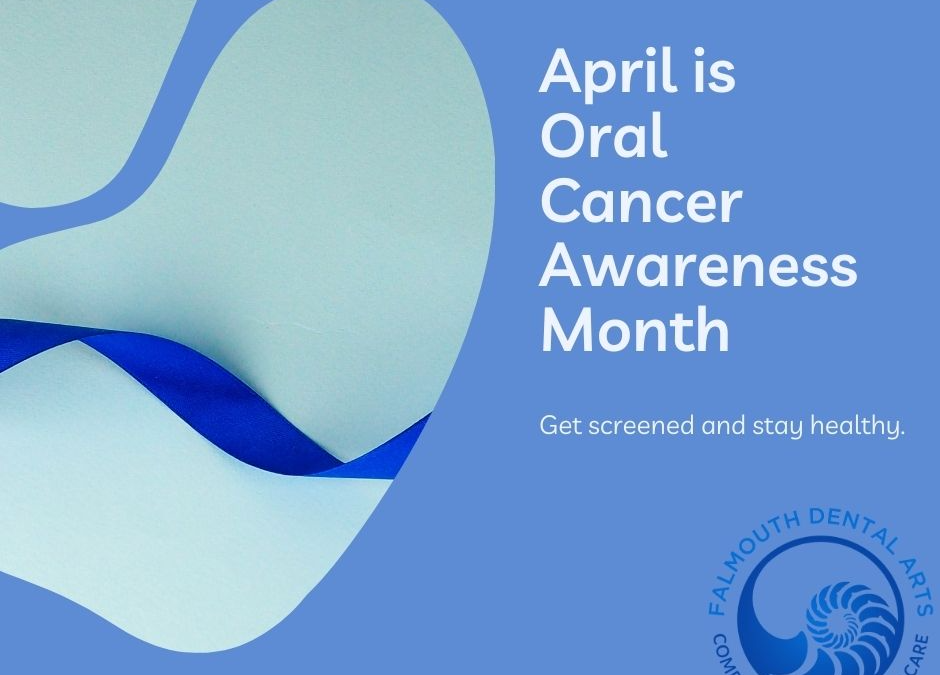
Apr 2, 2024
Did you know that regular dental care is a first line of defense for oral cancer? April is Oral Cancer Awareness month and is an opportunity to talk about the importance of early detection. It’s encouraging to note that when oral cancer is detected and treated early, there is a 80-90% survival rate. At Falmouth Dental Arts, we’ve long had a commitment to oral cancer screenings for our patients. Dr. Brunacini and Dr. Karagiorgos as well as our hygienists perform screenings during your regular check up appointments. To help raise awareness and answer questions, we wanted to provide some basic information about our screening procedures and common oral cancer warning signs.
Why Oral Cancer Awareness is Important
According to the Oral Cancer Foundation, about 58,500 people are diagnosed with oral cancer each year in America, which translates to 132 people each day. While smoking is the leading cause of oral cancer, there are increasingly more and more young people developing oral cancer due to the HPV virus.
FDA’s Oral Cancer Screening
At FDA, Dr. Brunacini, Dr. Karagiorgos, and our hygienists perform oral cancer screenings for our patients at every hygiene appointment. These screenings may include:
We start with a visual exam of the mouth, looking at the gum tissue, lips, checks, and tongue. Additionally we gently palpate or press on areas of the face and neck to check for any irregular lumps. If we have any concerns, we may offer to do a screening with VELscope. VELscope is a screening device that emits a blue light that quickly identifies abnormal cells before they are visible to the naked eye. It is a safe and non-invasive procedure and helpful for early detection of oral cancer.
FDA also performs CBCT 3D X-Rays which enables us to better visualize all of the structures within the head, neck, and mouth and assess our patients’ oral health. 3D imaging can be helpful in determining subsequent steps for the ideal treatment of an area of concern.
If we have any reason for concern after performing a screening, our next step would be to refer you to an oral surgeon for additional consultation and a possible biopsy. As your partner in oral health, we will remain involved every step of the way to provide support and follow-up care.
Oral Cancer Warning Signs
You also have an opportunity to screen for oral cancer in your home care. For example, if you notice any changes to your mouth or experience any pain or tenderness, you should let us know. Also, you can be on the lookout for some of the common warning signs for oral cancer, including:
- White or red patches in the mouth
- Sores that fail to heal
- Abnormal lumps in the gums or neck
- Difficulty chewing or swallowing
If you do discover an area of concern, please let us know so we can see you promptly for a thorough exam. As always, when you have any questions about your oral health or the oral cancer screening process, please don’t hesitate to call us! As your dentist, we are part of your healthcare team and happy to answer your questions!

Feb 4, 2024
At Falmouth Dental Arts, we are lucky to have a compassionate team of some of the best oral health care professionals in the world! Everyone loves coming to work each day to help our patients meet their oral health goals and receive the best care possible. Our Employee Spotlight series highlights the individuals who make FDA an incredible place to work and receive dental care.
This month, as we celebrate our 5th (!!!) year in our building, we are thrilled to put the spotlight on the man who started it all, the beloved Dr. Glen Knock.
Why did you decide to be a dentist?
Dr. Knock: I wanted to help people and was thinking about either medical school or dental school. I chose dental school after my wife had a baby and I’m glad I did!
When did you open your first practice?
Dr. Knock: In May 1974 – 50 years ago! – I opened a practice with Dr. Frank Adshead. We split our practice in 1986 and I moved to South Portland. Eventually Dr. Joe Long joined my practice for a time and in the late nineties we moved back to Falmouth. There used to be a state law that you could only have a dental practice named after the practicing dentist. A Supreme Court case changed that, which opened the way for a practice to be named something other than a practitioner’s name. I was looking for a name that would carry on after I retired, and sometime in the early 2000s we became known at Falmouth Dental Arts.
Tell us more about the idea behind the phrase “dental arts.”
Dr. Knock: There is an artistry to dentistry, if the dentist is conscientious. It is quite aesthetic…the cosmetic dentistry that can be done to help a person. Now there are machines that tell you all the color mixes! [Check out FDA’s Same-Day Crowns!]
What was a highlight from your dental career?
Dr. Knock: The biggest highlight for me was the people. I was blessed to be able to work with some people for 20 or 30 years. Francine was my assistant for 40 years! We had a lot of fun together. We were a good team.
Another highlight for me was ‘Dancing with the Dentists.’ It was really fun and we helped a lot of people.
Tell us how you came up with such an amazing idea!
Dr. Knock: My wife and I were fans of ‘Dancing with the Stars’ and we were taking ballroom dancing lessons. Something clicked and we thought how great it would be if dentists could raise money for charities like The Root Cellar. Also, it’s nice to show another side to dentists; we’re not just guys and gals in white coats drilling your teeth. The first year we raised $40,000. I feel really good about that.
Would you share some of your favorite or most interesting experiences from your career?
Dr. Knock: Some of our staff meetings – everything went off the rails and we had a blast solving something!
What do you miss most about working at FDA?
Dr. Knock: I miss the interactions with people, no doubt. My poor wife – I went from having 100 interactions a day and now I’m down to just one (her). I always really enjoyed talking to people and learning about them.
Thank you, Dr. Knock!

Jan 10, 2024
At Falmouth Dental Arts, we are lucky to have a compassionate team of some of the best oral health care professionals in the world! Everyone loves coming to work each day to help our patients meet their oral health goals and receive the best care possible. To celebrate our amazing team, we are starting a new Employee Spotlight series on our blog. We want to highlight the individuals who make FDA an incredible place to work and receive dental care.
This month, we are thrilled to put the spotlight on our fabulous office manager, Sue Libby. She got her start with the beloved Dr. Knock and this month she celebrates 35 years working in oral health care! Congratulations, Sue!
What is your favorite part of your job?
Sue: My job now is more focused on the team and their needs. I love working with the newer employees and teaching them about dentistry and all that comes with serving our patients. I also enjoy celebrating the milestones with our more “seasoned” team members.
Tell us about a “day-in-your life” at FDA.
Sue: I handle anything from patient questions to staff payroll. Most days I am watching to be sure things are running smoothly in the office.
What is your favorite part of your personal oral care routine?
Sue: I use an Oral B electric toothbrush exclusively to brush my teeth. My teeth feel squeeky clean when I finish!
What is something most of your patients would be surprised to learn about you?
Sue: My husband and I ran a small motel for 6 years in the Sebago Lakes Region. Not only did running my own business help me with some aspects of my current position, but the customer service approach at Falmouth Dental Arts helped me handle some of our traveling customers at the motel!
What is something you like to do when you’re not at work?
Sue: I love to cook and I enjoy sewing. I also just became a grandmother so I am now spending lots of time with my sweet grandson!
Do you have a favorite place or thing you love to do in Maine?
Sue: My family has a camp in the Jackman Area. I really enjoy getting away and spending time relaxing there in the summer. It’s a great place to unwind, disconnect, and just enjoy the peacefulness and beauty of our state.
Thank you, Sue!

Jan 4, 2024
We all want healthier habits. We set our New Year’s resolutions with the best of intentions, but it can feel so difficult to stick with them! We get it! Creating a new habit requires repetition and time…and it’s worth it! At FDA, we want to be your partner in oral health and support you in setting up a home care routine that works for you. So, to help you stick with your healthy habits, here are a few tips.
Start Small
“A journey of a thousand miles begins with a single step.” Focus on that first step you can take to improve your health. If you’re struggling to floss daily, start with flossing once a week. Make Fridays “Flossing Fridays!” As you achieve small goals you will be motivated to keep going. Plus once you see how you feel afterwards, it will encourage you to keep it up!
Stack it Up
An effective way to stick with a new habit is to combine it with an existing habit. This is called habit stacking. If you’d like to drink more water each day, try to do it alongside something else you do regularly. For example, after you brush your teeth…drink a glass of water! After you eat a meal…drink a glass of water! These two actions will become connected and overtime it will become part of your regular routine!
Celebrate Your Success
Help yourself stay motivated by celebrating your progress. It takes commitment and some hard work to make new habits. Give yourself the recognition you deserve! When you hit every “Flossing Friday” in a month, treat yourself to a movie or a nice meal out at your favorite restaurant. Find what gives you joy and make it a part of your new habit! Not only are you celebrating your success, but you’re celebrating your healthy life choices!
Another way to keep up with your healthy habits is to make yourself accountable by sharing your goals. Let us know what healthy habits you are working on when you come in for your regular check ups with Dr. Brunacini and Dr. Karagiorgos. We can help track your oral health progress and be your cheerleader for sticking with it! After all, we are your partner in oral health. Give us a call if you have questions or need to schedule your next appointment – 207.781.5900.

Jan 3, 2024
Happy New Year! A new year is a new beginning which makes it the perfect time to incorporate some positive changes into your oral health care routine. At FDA, we consider oral health an important part of your overall health. In other words, a healthy mouth contributes to a healthy whole body. Give yourself a boost with these three resolutions that can help transform your oral health care.
- Upgrade Your Brush!
When was the last time you replaced your toothbrush? According to the ADA, you should replace your toothbrush every three to four months. If you’ve had one of those pesky viruses that has been circulating this winter, that’s a good time to replace your brush, too. As you’re shopping for a new toothbrush, why not upgrade to an electric toothbrush! Our team of amazing hygienists swear by them. Electric toothbrushes really do a superior job removing plaque and cleaning the surfaces of your teeth. Many electric toothbrushes also have a built-in timer so you’re sure to brush for a full two minutes. Going electric is an easy way to improve your home care routine!
2. Eat with Your Teeth in Mind!
What you eat has an impact on your oral health, so consider your teeth next time you’re snacking! Of course we recommend limiting your sugar intake, but there are also foods you can choose that will give your oral health a boost. For example, foods that are high in calcium, like cheese and yogurt, will support the health of your pearly whites and your gums. Yogurt also has the benefit of being a probiotic, which will help keep your mouth balanced with healthy bacteria. Also, cheese contains a protein called casein which helps fortify your tooth enamel. Eating crunchy fruits and veggies will help clean your teeth as you chew, as well as stimulate saliva so your mouth gets rinsed of harmful bacteria. Plus they are chock full of vitamins and minerals that support your health! An apple a day…keeps you smiling away! ?
3. Get Regular Check Ups!
Have you been avoiding coming to the dentist? Prioritize your oral health and schedule regular check ups with Dr. Brunacini or Dr. Karagiorgos this year! Our top priority is making sure our patients receive the best oral care in an environment that is comfortable and supportive. If you feel nervous about visiting the dentist – we can help put you at ease! Give us a call and we can discuss our mild sedation options as well as other techniques we recommend for reducing dental anxiety. Our approach is all about designing a dental plan that fits your needs and budget so you can attain your dental health goals.
Embracing these easy New Year’s resolutions will help put you on the path to improved oral health. At FDA, we are your partner in oral care, and our compassionate team of professionals is always here to answer your questions and help you maintain a healthy and happy smile. If you need to schedule your next appointment, give us a call at 207.781.5900. Together, let’s make 2024 the year of radiant smiles and excellent oral health!





